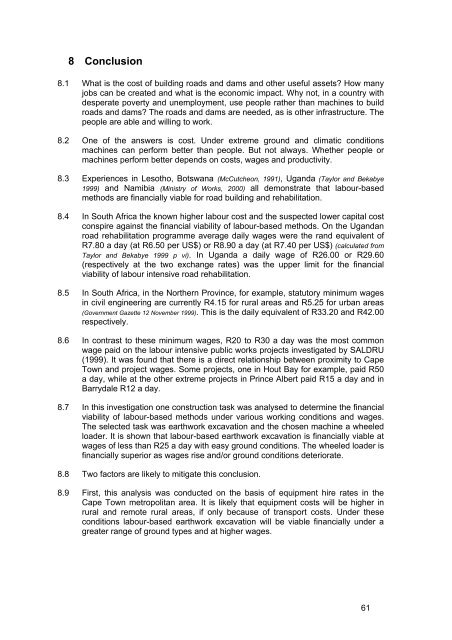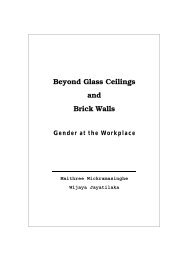SETP No. 14 The Economic Value of Incremental Employment in the ...
SETP No. 14 The Economic Value of Incremental Employment in the ...
SETP No. 14 The Economic Value of Incremental Employment in the ...
Create successful ePaper yourself
Turn your PDF publications into a flip-book with our unique Google optimized e-Paper software.
8 Conclusion<br />
8.1 What is <strong>the</strong> cost <strong>of</strong> build<strong>in</strong>g roads and dams and o<strong>the</strong>r useful assets? How many<br />
jobs can be created and what is <strong>the</strong> economic impact. Why not, <strong>in</strong> a country with<br />
desperate poverty and unemployment, use people ra<strong>the</strong>r than mach<strong>in</strong>es to build<br />
roads and dams? <strong>The</strong> roads and dams are needed, as is o<strong>the</strong>r <strong>in</strong>frastructure. <strong>The</strong><br />
people are able and will<strong>in</strong>g to work.<br />
8.2 One <strong>of</strong> <strong>the</strong> answers is cost. Under extreme ground and climatic conditions<br />
mach<strong>in</strong>es can perform better than people. But not always. Whe<strong>the</strong>r people or<br />
mach<strong>in</strong>es perform better depends on costs, wages and productivity.<br />
8.3 Experiences <strong>in</strong> Lesotho, Botswana (McCutcheon, 1991), Uganda (Taylor and Bekabye<br />
1999) and Namibia (M<strong>in</strong>istry <strong>of</strong> Works, 2000) all demonstrate that labour-based<br />
methods are f<strong>in</strong>ancially viable for road build<strong>in</strong>g and rehabilitation.<br />
8.4 In South Africa <strong>the</strong> known higher labour cost and <strong>the</strong> suspected lower capital cost<br />
conspire aga<strong>in</strong>st <strong>the</strong> f<strong>in</strong>ancial viability <strong>of</strong> labour-based methods. On <strong>the</strong> Ugandan<br />
road rehabilitation programme average daily wages were <strong>the</strong> rand equivalent <strong>of</strong><br />
R7.80 a day (at R6.50 per US$) or R8.90 a day (at R7.40 per US$) (calculated from<br />
Taylor and Bekabye 1999 p vi). In Uganda a daily wage <strong>of</strong> R26.00 or R29.60<br />
(respectively at <strong>the</strong> two exchange rates) was <strong>the</strong> upper limit for <strong>the</strong> f<strong>in</strong>ancial<br />
viability <strong>of</strong> labour <strong>in</strong>tensive road rehabilitation.<br />
8.5 In South Africa, <strong>in</strong> <strong>the</strong> <strong>No</strong>r<strong>the</strong>rn Prov<strong>in</strong>ce, for example, statutory m<strong>in</strong>imum wages<br />
<strong>in</strong> civil eng<strong>in</strong>eer<strong>in</strong>g are currently R4.15 for rural areas and R5.25 for urban areas<br />
(Government Gazette 12 <strong>No</strong>vember 1999). This is <strong>the</strong> daily equivalent <strong>of</strong> R33.20 and R42.00<br />
respectively.<br />
8.6 In contrast to <strong>the</strong>se m<strong>in</strong>imum wages, R20 to R30 a day was <strong>the</strong> most common<br />
wage paid on <strong>the</strong> labour <strong>in</strong>tensive public works projects <strong>in</strong>vestigated by SALDRU<br />
(1999). It was found that <strong>the</strong>re is a direct relationship between proximity to Cape<br />
Town and project wages. Some projects, one <strong>in</strong> Hout Bay for example, paid R50<br />
a day, while at <strong>the</strong> o<strong>the</strong>r extreme projects <strong>in</strong> Pr<strong>in</strong>ce Albert paid R15 a day and <strong>in</strong><br />
Barrydale R12 a day.<br />
8.7 In this <strong>in</strong>vestigation one construction task was analysed to determ<strong>in</strong>e <strong>the</strong> f<strong>in</strong>ancial<br />
viability <strong>of</strong> labour-based methods under various work<strong>in</strong>g conditions and wages.<br />
<strong>The</strong> selected task was earthwork excavation and <strong>the</strong> chosen mach<strong>in</strong>e a wheeled<br />
loader. It is shown that labour-based earthwork excavation is f<strong>in</strong>ancially viable at<br />
wages <strong>of</strong> less than R25 a day with easy ground conditions. <strong>The</strong> wheeled loader is<br />
f<strong>in</strong>ancially superior as wages rise and/or ground conditions deteriorate.<br />
8.8 Two factors are likely to mitigate this conclusion.<br />
8.9 First, this analysis was conducted on <strong>the</strong> basis <strong>of</strong> equipment hire rates <strong>in</strong> <strong>the</strong><br />
Cape Town metropolitan area. It is likely that equipment costs will be higher <strong>in</strong><br />
rural and remote rural areas, if only because <strong>of</strong> transport costs. Under <strong>the</strong>se<br />
conditions labour-based earthwork excavation will be viable f<strong>in</strong>ancially under a<br />
greater range <strong>of</strong> ground types and at higher wages.<br />
61
















